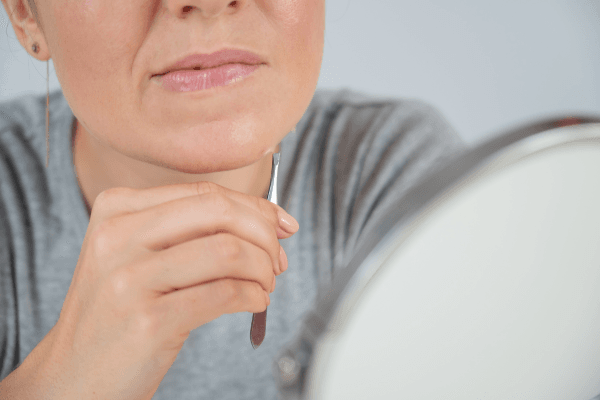A more common condition among women that causes coarse dark hair growth in areas where hair growth is common in men like the chin, upper lip, chest, abdomen and back. It is referred to as peach fuzz.
It is a complex condition that needs a holistic approach. Medical treatments and cosmetic procedures may help some women, lifestyle changes and dietary habits have a greater impact on the symptoms of hirsutism.
This condition can be challenging both emotionally and physically. It affects self-esteem and quality of life in many women.
In this blog let us understand what hirsutism is, it causes and how we can alleviate the symptoms.
What is hirsutism?
A condition where excess growth of hair occurs in places where it is not usually present. It occurs mainly in women. The hair is dark and thick compared to the general hair growth. Hirsutism occurs in men also but it is mostly hard to identify. It affects 10% of the women in the United States.
It is primarily caused by excess androgen also known as male hormones. This increased production causes excess hair growth which is typical of male pattern.
Hirsutism can occur in women, who have a family history of polycystic ovary syndrome and congenital adrenal hyperplasia. Obesity also contributes to the development of hirsutism.
Symptoms of hirsutism
The main symptom of hirsutism is the development of secondary sex characteristics also known as virilisation.
Some of the symptoms of virilisation are:
- Acne
- Deeper voice
- Decreased breast size
- Increased muscle development
- Clitoris enlargement (clitoromegaly)
- Increased sex drive.
Causes of Hirsutism
The causes can be due to ovarian or adrenal origin, and or tumour.
1. Polycystic ovary syndrome
70% of cases of hirsutism are caused by polycystic ovary syndrome. The presence of chronic anovulation, clinical or biological hyperandrogenism, and polycystic ovaries confirms the diagnosis of PCOS.
Other symptoms include weight gain, acne, alopecia, insulin resistance, infertility, and acanthosis nigricans. In PCOS, the levels of androgen are slightly elevated in some cases it may be normal.
Insulin resistance, obesity, and infertility are characteristics of PCOS. The ovaries and adrenal glands are stimulated to produce more androgens if there is insulin resistance or hyperinsulinaemia. Hepatic synthesis of sex hormone-binding globulin, which binds testosterone and makes it inactive, is inhibited by hyperinsulinaemia.
2. Idiopathic
Less than 20% of cases of hirsutism are due to idiopathic hyperandrogenaemia, which is defined by normal ovulatory cycles and the absence of any other known cause of increased androgen levels. In 4–7% of cases, androgen levels are normal, which makes it an exclusion diagnosis.
3. Adrenal hyperplasia
Adrenal hyperplasia, an abnormality in the adrenal cortisol synthesis that redirects precursors into the androgen synthesis pathway, affects less than 5% of individuals. Non-classic adrenal hyperplasia is asymptomatic until after puberty when women develop menstrual dysfunction and anovulation.
4. Adrogen secreting tumours
Androgen-secreting tumours are rare in women. Adrenal or ovarian neoplasms can arise, and they frequently result in significant increases in androgen levels. Over 50% of them are cancerous. A palpable mass in the abdomen or pelvis, virilisation, or a sudden onset of hirsutism all suggest the possibility of an androgen-secreting tumour.
Other causes include iatrogenic hirsutism, acromegaly, Cushing syndrome, hyperprolactinaemia, and thyroid dysfunction.
Treatment
A) Pharmacological methods
1. Anti-androgen medications
Anti-androgens are frequently prescribed to block the effects of androgens at the hair follicle level, reducing hair growth and preventing further development of hirsutism. The most common drugs are spironolactone, finasteride and flutamide.
2. Oral contraceptives
It is often the first-line treatment for hirsutism, especially in women with PCOS. They decrease ovarian androgen production by suppressing luteinising hormone and follicle-stimulating hormone release. Combination pills containing oestrogen and progestin effectively reduce the testosterone levels by increasing sex hormone-binding globulin which binds free testosterone in the bloodstream, making it less available for conversion into Dihydrotestosterone (DHT).
3. Insulin-sensitising agents
Insulin resistance is common in hirsutism, especially in PCOS patients. Insulin-sensitising agents like metformin and pioglitazone are beneficial. These medications enhance insulin sensitivity, reducing hyperinsulinaemia, which subsequently lowers androgen production by ovaries. Metformin, particularly, improves glucose metabolism and decreases circulating androgens, aiding in the management of hirsutism.
B) Cosmetic treatment
1. Laser hair removal
Laser hair removal is a long-term treatment that uses high-intensity light to target melanin within the hair follicle, damaging the follicle and inhibiting hair regrowth. It is most effective on darker hair, as melanin absorbs the laser energy better. Repeated treatments are typically required, and some hair regrowth may occur, though it is often finer and lighter in colour.
2. Topical treatment
Eflornithine cream is a topical agent that inhibits ornithine decarboxylase, an enzyme necessary for hair growth. Applied to skin, it slows hair growth but does not permanently remove hair, making it useful as an adjunctive therapy in combination with laser or electrolysis treatments.
C) Lifestyle modifications
Weight loss – In overweight women, even a slight weight reduction can significantly lower androgen levels, reduce insulin resistance, and improve hirsutism. Weight loss helps normalise the menstrual cycle and improves the body’s response to insulin, which in turn can reduce androgen production and the severity of hair growth.
Dietary factors in hirsutism
While diet isn’t the primary cause, it can influence hormonal balance and potentially exacerbate the condition. Come key points regarding the relationship between diet, lifestyle and hirsutism:
Insulin resistance – A diet high in refined carbohydrates and sugars can lead to insulin resistance, which may increase androgen production and worsen hirsutism.
Obesity – Excess body fat can increase the production of androgens and oestrogen potentially contributing to hirsutism.
Nutrient deficiencies – Lack of certain nutrients, such as vitamin D, B vitamins and zinc may affect hormone balance.
Phytoestrogens – Some plant compounds like those found in soy products, may influence hormone levels and potentially affect hair growth patterns.
Endocrine disruptors – Certain chemicals in food packaging or pesticides may disrupt hormone balance and potentially contribute to hirsutism.
Alcohol consumption – Excessive alcohol intake can affect liver function and hormone metabolism and may worsen the condition.
It is important to note that while diet and lifestyle factors can influence hirsutism, the primary causes are often related to underlying medical conditions such as polycystic ovary syndrome, congenital adrenal hyperplasia or certain medications. A balanced diet, regular exercise and maintaining a healthy weight can support overall hormonal health, but medical evaluation and treatment are typically necessary for managing hirsutism effectively.
Kripa N,
Senior Clinical Dietitian, Simplyweight













